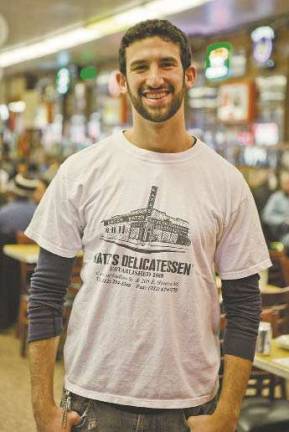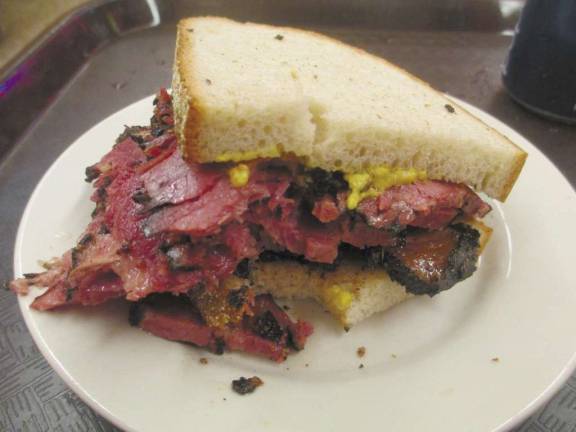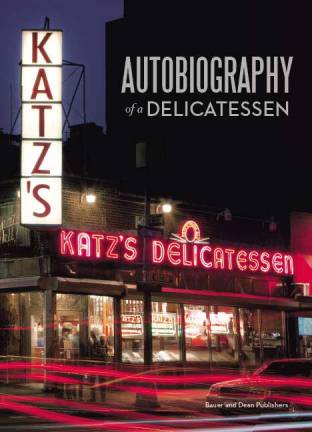The Meat of the Lower East



Fifth-generation owner Jake Dell dishes on what makes his deli so special
[](http://nypress.com/wp-content/uploads/2013/10/Celeb__Jake_opt.jpeg)Katz's Delicatessen can serve anywhere from 400 to 4,000 customers a day. That's a lot of pastrami. But a deli doesn't survive for 125 years on the meat alone. At 2 p.m., the lunch rush is in full swing, and I find Jake Dell at a table, eating a knoblewurst sandwich. Although sampling the food is a delicious perk, Dell, 26, whose grandfather Marty bought the deli in 1988, thinks the best part of his job is hearing the stories of customers' personal attachment to the restaurant. "There's this deep emotional connection," he said. Since there was no cohesive history yet written down, the book Katz's Autobiography of a Delicatessen was created to commemorate their milestone anniversary. Released on October 1st, the photo/history book captures the essence of the customers, staff, and food that make the deli what it was in the late 1800s and still is today. With the landscape of Manhattan always changing, Katz's reminds us of our flavorful past. Dell acknowledges that by saying, "Change is inevitable in New York. But this doesn't need to be the place that changes."
Your grandfather wanted you to join the business, because at one time you were applying to medical school.
I thought I wanted to be a doctor; I realized that was stupid. [Laughs] I love this place; I really do. This place has fed me for however-many years - it's sent me to school, it literally saw me become a man at my Bar Mitzvah. This place is so integral to my life that, of course, I was going to give a year back and let my dad take some time to relax. That's how it started. There were these creeping doubts, like I needed to make sure I really didn't want to be at Katz's and really did want to be a doctor. At the end of the year, I said, "What am I thinking?"
In the book it says you work 70 hours a week. What's a typical day like for you?
[](http://nypress.com/wp-content/uploads/2013/10/Celeb_Pastrami_opt.jpeg)I work a lot, yeah. Now I work less because I'm going to school. Probably 10 of those hours are spent at school now. I'm getting my MBA from NYU. I go part time, nights and weekends. In the morning, I come in and do what needs to be done in the office. I address issues that may have come up, call people back. I like to be on the floor once the lunch rush hits and usually am here till the rush dies down at 3 or 4. Then go back to emails or calls, or do interviews. If I have class, I leave. Otherwise, I stay through dinner. We do shipping sometimes overnight and I've stayed until 6 in the morning.
On the weekends, you're open 24 hours.
This neighborhood has changed drastically over the last 10 to 15 years. Now it's a hotspot and Ludlow and Orchard is a destination. They close off the streets to traffic. Two summers ago we recognized this. It's been great. It has its own set of headaches, but it's a lot of fun. There are a lot of people I run into outside of here who say, "I know that place, I've been there at 3 in the morning." They have this attachment to it, and that's what I care about.
How did this book come about?
Beth Daugherty [of Bauer and Dean Publishers] approached me with the idea. It was a little more general. It was basically saying that we needed a snapshot in time of Katz's. This was last year and we were approaching our 125th anniversary. I thought it was important, before it's too late, to get all this in writing. I can talk about what's happening right now, but why write it when we can show it through the photography?
In the book, each employee's picture is featured from cashiers, to cutters, to security.
Honestly, without them, there'd be no store. Half these guys - their families have worked here before them. Everyone is equally important. My busboys - without them the restaurant looks like a mess. Without the guys in the kitchen, there's no matzo ball soup or latkes coming out.
Adam Richman writes the book's foreword and says you have "arguably the best pastrami on planet Earth." How did your exposure on the Food Network change your business?
That was one of many factors. My father and my uncle did a wonderful job of adapting with the times, and that meant being on TV. I think this place naturally films well; we're very lucky. A lot of our regulars included guys like Adam Richman, Emeril Lagasse, Mario Batali. Daniel Boulud made a bone marrow dish at DBGB's that had a little piece of Katz's pastrami on it.
I thought it was interesting that your mom came up with the idea to make Katz's a stop on tours.
Tour groups come in here. A lot of people want to say "only tourists go there," and I get that. A lot of the times that has to do with the time of the day that you come. Quite frankly, a lot of New Yorkers just take their food to go because they're on the run.
Where's the farthest you've shipped to?
We've shipped the meats to every city imaginable in the country. Internationally, we started shipping our salamis during World War II. Our slogan is, "Send a Salami to Your Boy in the Army." We've sent to Afghanistan, Iraq, Iran, anywhere there are U.S. soldiers. That's only the salami, anything else would go bad. We are going to start a program where if you don't know the solider, you can donate a salami.
What happened here during Hurricane Sandy last year?
We were open. We had to shut down for a day. I had to buy dry ice to preserve all the meat. We were giving away thousands of pounds to shelters and giving the volunteers food. There was one tourist couple who came in - I'll never forget this - and said, "So are you guys serving today?" They made the trek from the Upper West Side on Wednesday, when there was no power down here. They were that committed.
To learn more about Katz's, visit www.katzsdelicatessen.com
On October 22nd, Katz's is launching The Space, a pop-up gallery and apparel shop filled with local artists' deli-themed creations.